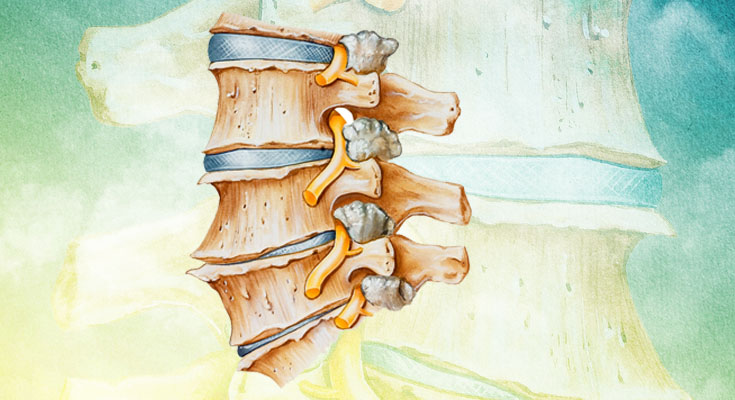L4 and L5 Lumbar Spine are the lowest vertebrae of our lumbar spine and these two spinal motion segments along with joints, soft tissues, intervertebral disc and nerves.
These two vertebrae provide various types of functions like they help to support the upper body and allow trunk motion in multiple directions.
L4 and L5 are also capable of heavy load-bearing function with a wide range of flexibility. And, therefore the two spinal segments, L4-L5 are more at risk of developing pain due to injury or degenerative changes in comparison to other lumbar segments.
Understand the Structure of L4 and L5 Motion Segment:
Each vertebra consists of a vertebral body one in the front and another vertebral arch at the back. The vertebral has 3 bony protrusions like a prominent spinous process in the middle and two transverse processes on either side.

The region which is lies between the spinous process and the transverse process is called the lamina. And, the region which lies between the vertebral body and the transverse process is known as the pedicle.
The vertebrae are connected or say joined by the facet joints and the facet joints are covered by articulating cartilage. These cartilages provide a smooth movement between the joint surface.
The upper and the lower ends of the vertebral body both are covered with body endplates. These endplates help to resists from compressive loads places on the spine. And, another thing about L4 and L5 vertebral bodies is that they both are taller in front than behind.
L4-L5 intervertebral discs are made of nucleus pulposus, it is get-like material which is surrounded by a thick fibrous called annulus fibrosus. Annulus fibrosus is situated between the vertebral bodies of L4 and L5.
How these discs (L4-L5 Spinal Segment) help our vertebral? These discs have a shock-absorbing and cushioning function which helps to prevent our vertebrae from grinding against each other at the time of spinal movements.
Know More About L4 Spinal Nerve
The “L4 spinal nerve” roots connect with other nerves to develop bigger nerves that can be extended down the spine and further travels down each of our legs.
The L4 spinal nerve roots exit the spinal cord with the help of small bony opening on the right and the left side of our spinal canal.
The areas of our skin that receive sensations through L4 spinal nerve is known as L4 dermatome. And the body parts which receive sensation through L4 spinal nerve include knee, thigh, leg and foot.
L4 spinal nerve also controls a group of muscles called L4 myotome, which includes parts of several muscles in the back, leg, foot, pelvis and thigh.
L4-L5 motion segment provides a bony enclosure for the cauda equina which means nerves that continue down from the spinal cord and other fragile structures.
Common Injuries take Place at L4-L5 Spine Segment
What makes L4-L5 motion segments prone to facet joint-related issues is the high degree of mobility. And the problems which occur due to “L4-L5” high degree of mobility are synovial cyst (fluid-filled sac), osteoarthritis, and instability of the facets.
Due to decreased movement and increased loads at the L4-L5 motion segment, the risk of degeneration is also high. And when degeneration happens it may also affect the lordosis of the “lumbar spine“.
Due to the concentration of compressive loads in the regions, a fracture of the pars interarticularis can occur at the L4-L5 level. Interarticularis is a small segment of bone from the vertebral arch joining the facet joints. And, in Pars stress reaction, there is a condition in which the bones does not break, but becomes stressed.
Another problem of L4-L5 motion segment is degenerative disc because with age the angle of L4-L5 facet joint changes which leads to the risk of developing spondylolisthesis. This also happens due to the degenerative changes in people over 60 years of age.
Compression of the nerve roots in the stenosis area caused by degenerative changes and narrowing of bony openings for nerves due to the presence of bone spurs (abnormal bone growth).
Facet joints dislocation due to external trauma from motor vehicle accidents or fall. Such injuries may also lead to fracture and damage to the cauda equine.
Other reason which may affect L4-L5 vertebrae and spinal segments are rare tumours and infections.
Sign and Symptoms caused by L4-L5 motion segments
L4-L5 also causes referred pain in the muscles or joints, which also includes radicular symptoms that travel through the nerves.
Stiffness in the back, and referred pain from L4-L5 which stays within the lower back and feels like a dull ache.
Based on the severity of the underlying cause and its severity, the L4-L5 motion segment may lead to lumbar radicular pain of L4-L5 spinal nerves also known as sciatica.
Here are the common symptoms of sciatica:
– Numbness in the parts like leg, foot, thigh and toes.
– Weakness and pain while moving and twisting parts like leg, foot, thigh and toes.
– Sudden pain or sensation like needle-and-pins or tingling.
– Sharp pain, like a burning or shooting feeling that origins in the lower back and travels down the leg in the distribution of a specific nerve and sometimes this can also affect your foot.
In cases like lumbar radiculopathy, this mainly affects one leg at a time, but sometime both legs might get affected together.
In other cases, if an injury happens to the cauda equine this may lead to weakness, tingling, severe pain, numbness and paralysis in both the legs.
This is a serious medical emergency which needs immediate treatment to protect the functioning of your legs and to restore bladder or bowel function also because in some cases this injury may also lead to the loss of bladder or bowel functioning.
In such situations, the medical expert first prefers to treat with nonsurgical treatments to reduce the symptoms that stem from L4-L5 and in rare cases, surgery may be considered.
SureShot Herbal Medicines for Sciatica Pain Treatment:
SureShot Ayurveda provides Ayurvedic Treatment for sciatica pain (cervical pain, back pain and slipped disc).
And, if you are afraid of getting surgery or not sure about the after surgery results, SureShot herbal medicines can be one of the best herbal treatment. These medicines are made of 100% natural herbs, and have no side-effects, unlike allopathic treatments.
SureShot Herbal medicines are the only medicine in the world which can cure sciatica pain completely.
SureShot team, we make sure to provide the best help from our side to provide you with the best Ayurvedic treatment for sciatica pain.

